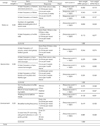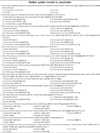Abstract
Purpose
Screening of preschool-age children for nutrition programs to improve dietary intake and behaviors requires cost-effective and easily administered validated assessment tools. The purpose of this study was to develop a parent/caregiver-administered instrument for measuring diet quality and behaviors of preschoolers as a nutrition quotient for preschoolers (NQ-P).
Methods
Development of NQ-P was carried out in three steps: item generation, item reduction, and validation. The 24-h dietary record was selected as the gold standard reference tool. The 38 items of the NQ-P checklist were derived from a systematic literature review, expert in-depth interviews, statistical analysis of the fifth Korean National Health and Nutrition Examination Survey data, and national nutrition policies and recommendations. Self-administered questionnaires were delivered to parents who recorded 24-h dietary intakes of 100 responders aged 3~5 yr. Pearson's correlation was used to measure the level of agreement between questionnaires. Item reduction was performed, and 20 items were selected based on survey results, expert reviews, and priorities of national nutrition policy and recommendations. The 412 nationwide subjects sampled through daycare centers completed the 20-item checklist questionnaire. The construct validity of the NQ-P was assessed using confirmatory factor analysis, LISREL.
Results
After analyses of exploratory factors, NQ-P items identified three dimensions of diet (balance, moderation, and environment). The three-factor structure accounted for 49.28% of the total variance. Standardized path coefficients were used as weights of the items. The NQ-P and three-factor scores of the subjects were calculated by the obtained weights of the questionnaire items.
Figures and Tables
Fig. 2
Comparison of percentage of nutrient intake of the children to recommended nutrient intake (RNI) or adequate intake (AI) according to NQ-P score four-grade criterion of samples from the pilot survey. a b : Different alphabets indicate significant differences by Duncan's multiple test (p < 0.05).

Table 3
Results of exploratory factor analysis of the 14 items selected by LISREL analysis (n = 412)

References
1. Marotz LR. Feeding toddlers and young children. In : Marotz LR, editor. Health, Safety, and Nutrition for the Young Child. 7th ed. Clifton Park (NY): Thomson Delmar Learning;2009. p. 428–447.
2. Smithers LG, Golley RK, Brazionis L, Emmett P, Northstone K, Lynch JW. Dietary patterns of infants and toddlers are associated with nutrient intakes. Nutrients. 2012; 4(8):935–948.

3. Northstone K, Emmett PM. Are dietary patterns stable throughout early and mid-childhood? A birth cohort study. Br J Nutr. 2008; 100(5):1069–1076.

4. Mikkilä V, Räsänen L, Raitakari OT, Pietinen P, Viikari J. Consistent dietary patterns dentified from childhood to adulthood: the cardiovascular risk in young Finns study. Br J Nutr. 2005; 93(6):923–931.
5. Randall Simpson JA, Keller HH, Rysdale LA, Beyers JE. Nutrition screening tool for every preschooler (NutriSTEP): validation and test-retest reliability of a parent-administered questionnaire assessing nutrition risk of preschoolers. Eur J Clin Nutr. 2008; 62(6):770–780.

6. Randall Simpson J, Gumbley J, Whyte K, Lac J, Morra C, Rysdale L, Turfryer M, McGibbon K, Beyers J, Keller H. Development, reliability, and validity testing of toddler NutriSTEP: a nutrition risk screening questionnaire for children 18-35 months of age. Appl Physiol Nutr Metab. 2015; 40(9):877–886.

7. Manios Y, Kourlaba G, Grammatikaki E, Androutsos O, Moschonis G, Roma-Giannikou E. Development of a diet-lifestyle quality index for young children and its relation to obesity: the preschoolers diet-lifestyle index. Public Health Nutr. 2010; 13(12):2000–2009.

8. Feskanich D, Rockett HR, Colditz GA. Modifying the healthy eating index to assess diet quality in children and adolescents. J Am Diet Assoc. 2004; 104(9):1375–1383.

9. Kranz S, Hartman T, Siega-Riz AM, Herring AH. A diet quality index for American preschoolers based on current dietary intake recommendations and an indicator of energy balance. J Am Diet Assoc. 2006; 106(10):1594–1604.

10. Kranz S, Findeis JL, Shrestha SS. Use of the revised children's diet quality index to assess preschooler's diet quality, its sociodemographic predictors, and its association with body weight status. J Pediatr (Rio J). 2008; 84(1):26–34.

11. Golley RK, Hendrie GA, McNaughton SA. Scores on the dietary guideline index for children and adolescents are associated with nutrient intake and socio-economic position but not adiposity. J Nutr. 2011; 141(7):1340–1347.

12. Arimond M, Ruel MT. Dietary diversity is associated with child nutritional status: evidence from 11 demographic and health surveys. J Nutr. 2004; 134(10):2579–2585.

13. Kang MH, Lee JS, Kim HY, Kwon S, Choi YS, Chung HR, Kwak TK, Cho YH. Selecting items of a food behavior checklist for the development of nutrition quotient (NQ) for children. Korean J Nutr. 2012; 45(4):372–389.

14. Kim HY, Kwon S, Lee JS, Choi YS, Chung HR, Kwak TK, Park J, Kang MH. Development of a nutrition quotient (NQ) equation modeling for children and the evaluation of its construct validity. Korean J Nutr. 2012; 45(4):390–399.

15. Yon M, Hyun T. Development of an eating habit checklist for screening elementary school children at high risk of energy overintake. Korean J Nutr. 2008; 41(5):414–427.
16. Yon M, Hyun T. Development of an eating habit checklist for screening elementary school children at risk of inadequate micronutrient intake. Korean J Nutr. 2009; 42(1):38–47.
17. Choi Y, You Y, Go KA, Tserendejid Z, You HJ, Lee JE, Lee S, Park HR. The prevalence of obesity and the level of adherence to the Korean dietary action guides in Korean preschool children. Nutr Res Pract. 2013; 7(3):207–215.

18. Ministry of Health and Welfare (KR). The 2009 dietary guidelines for Koreans. Seoul: Ministry of Health and Welfare;2009.
19. Ministry of Food and Drug Safety (KR). Guidelines of child-care foodservice management. Cheongju: Ministry of Food and Drug Safety;2015.
20. Hanley JA, McNeil BJ. The meaning and use of the area under a receiver operating characteristic (ROC) curve. Radiology. 1982; 143(1):29–36.

22. Story M, Kaphingst KM, Robinson-O'Brien R, Glanz K. Creating healthy food and eating environments: policy and environmental approaches. Annu Rev Public Health. 2008; 29(1):253–272.

23. Yoo JS, Choi YS. Evaluation of items for the food behavior checklist and nutrition quotient score on children in rural areas of Gyeongbuk. J Nutr Health. 2013; 46(5):427–439.

24. Kim JH, Jung YH. Evaluation of food behavior and nutritional status of preschool children in Nowon-gu of Seoul by using nutrition quotient (NQ). Korean J Community Nutr. 2014; 19(1):1–11.

25. Kennedy ET, Ohls J, Carlson S, Fleming K. The healthy eating index: design and applications. J Am Diet Assoc. 1995; 95(10):1103–1108.
26. Kleiser C, Mensink GB, Scheidt-Nave C, Kurth BM. HuSKY: a healthy nutrition score based on food intake of children and adolescents in Germany. Br J Nutr. 2009; 102(4):610–618.

27. Shim JE, Kim J, Mathai RA. STRONG Kids Research Team. Associations of infant feeding practices and picky eating behaviors of preschool children. J Am Diet Assoc. 2011; 111(9):1363–1368.

28. Kim YK, Song IH. Factors affecting the physical growth and eating habits of children at daycare centers located in Yangyang-gun in Gangwon province. J Korean Soc Matern Child Health. 2011; 15(2):141–151.
29. Seo SJ, Shin HS. A study on eating behavior, developmental outcomes of young children, and nutritional attitude and knowledge levels of mothers. J East Asian Soc Diet Life. 2009; 19(6):839–845.
30. Bae JW, Oh MS. Parental perception and dietary behaviors of preschool children with environment-friendly food service in kindergarten. Korean J Food Cult. 2012; 27(6):646–658.

31. McCurdy K, Gorman KS. Measuring family food environments in diverse families with young children. Appetite. 2010; 54(3):615–618.

32. Seo JY, Lee IS, Choi BS. Study of food intakes and eating patterns among preschool children in Daegu area. Nutrient intakes and dietary habits associated with body weight status. Korean J Community Nutr. 2009; 14(6):710–721.
33. Shim JE, Yoon JH, Kim K, Paik HY. Association between picky eating behaviors and growth in preschool children. J Nutr Health. 2013; 46(5):418–426.

34. Kwon JY, Park H, Whang EM. The effects of milk group intake to dietary diversity score and nutrient adequacy ratio among toddler. Korean J Nutr. 2001; 34(1):30–38.
35. Shin KO, Chung KH, Park HS. Evaluation of the health status of preschool children stratified based on the weight-length index (WLI). Nutr Res Pract. 2010; 4(5):383–392.

36. Kourlaba G, Kondaki K, Grammatikaki E, Roma-Giannikou E, Manios Y. Diet quality of preschool children and maternal perceptions/misperceptions: the GENESIS study. Public Health. 2009; 123(11):738–742.

37. Serdula MK, Alexander MP, Scanlon KS, Bowman BA. What are preschool children eating? A review of dietary assessment. Annu Rev Nutr. 2001; 21:475–498.

38. United States Department of Agriculture. Food and Nutrition Service. Nutrition and wellness tips for young children: build a healthy plate with whole grains [Internet]. Alexandria (VA): Food and Nutrition Service;2015. cited 2015 Apr 8. Available from: http://www.teamnutrition.usda.gov/library.html.
39. Dubois L, Farmer AP, Girard M, Peterson K. Preschool children's eating behaviours are related to dietary adequacy and body weight. Eur J Clin Nutr. 2007; 61(7):846–855.

40. Wright CM, Parkinson KN, Shipton D, Drewett RF. How do toddler eating problems relate to their eating behavior, food preferences, and growth? Pediatrics. 2007; 120(4):e1069–e1075.

41. Whitaker RC, Wright JA, Pepe MS, Seidel KD, Dietz WH. Predicting obesity in young adulthood from childhood and parental obesity. N Engl J Med. 1997; 337(13):869–873.

42. Benjamin SE, Cradock A, Walker EM, Slining M, Gillman MW. Obesity prevention in child care: a review of U.S. state regulations. BMC Public Health. 2008; 8:188.

43. Ollson S. Obesity in the early childhood years: state of the science and implementation of promising solutions: workshop summary. Washington, D.C.: National Academies Press;2016.
44. Campbell K, Crawford D. Family food environments as determinants of preschool-aged children's eating behaviours: implications for obesity prevention policy. A review. Aust J Nutr Diet. 2001; 58(1):19–25.
45. Bennett CA, de Silva-Sanigorski AM, Nichols M, Bell AC, Swinburn BA. Assessing the intake of obesity-related foods and beverages in young children: comparison of a simple population survey with 24 hr-recall. Int J Behav Nutr Phys Act. 2009; 6:71.

46. Steyn NP, Nel JH, Nantel G, Kennedy G, Labadarios D. Food variety and dietary diversity scores in children: are they good indicators of dietary adequacy? Public Health Nutr. 2006; 9(5):644–650.

47. Chun IA, Han MA, Park J, Choi SW, Ryu SY. The association between parental characteristics and dietary habits of early childhood. J Korean Soc Matern Child Health. 2013; 17(1):150–161.
48. Do NH, Kim JS, Ha MK. Survey on time use of infants and preschool children: research report 2013-10. Seoul: Korea Institute of Child Care and Education;2013.




 PDF
PDF ePub
ePub Citation
Citation Print
Print









 XML Download
XML Download